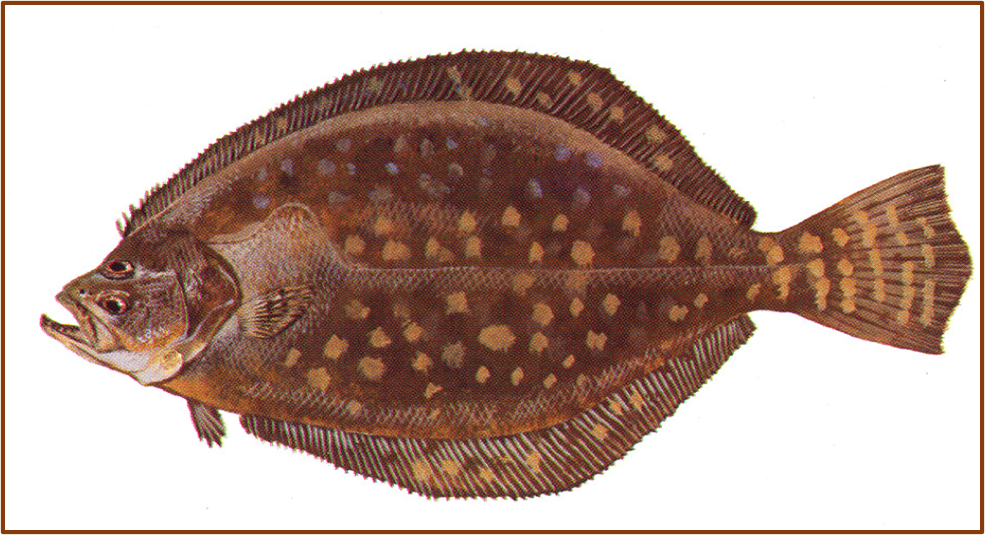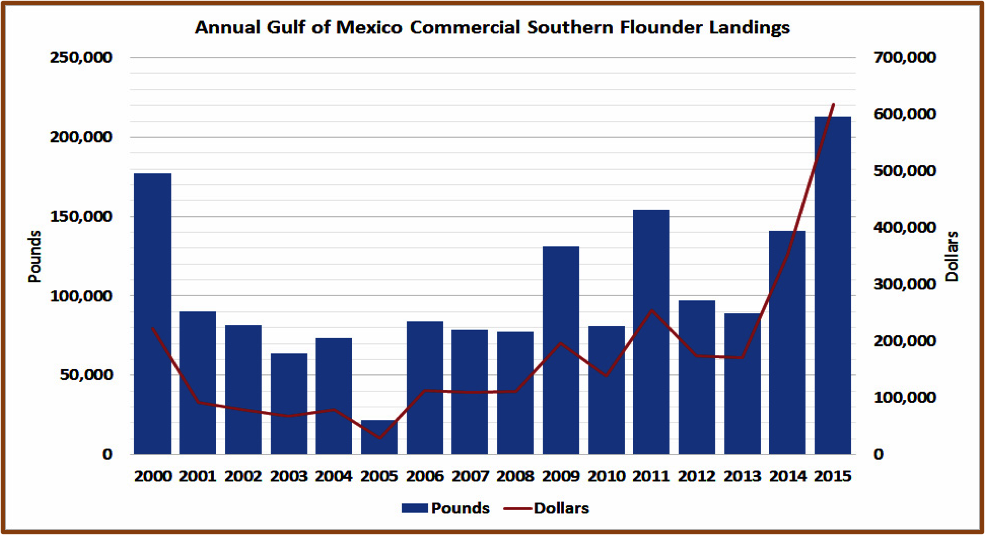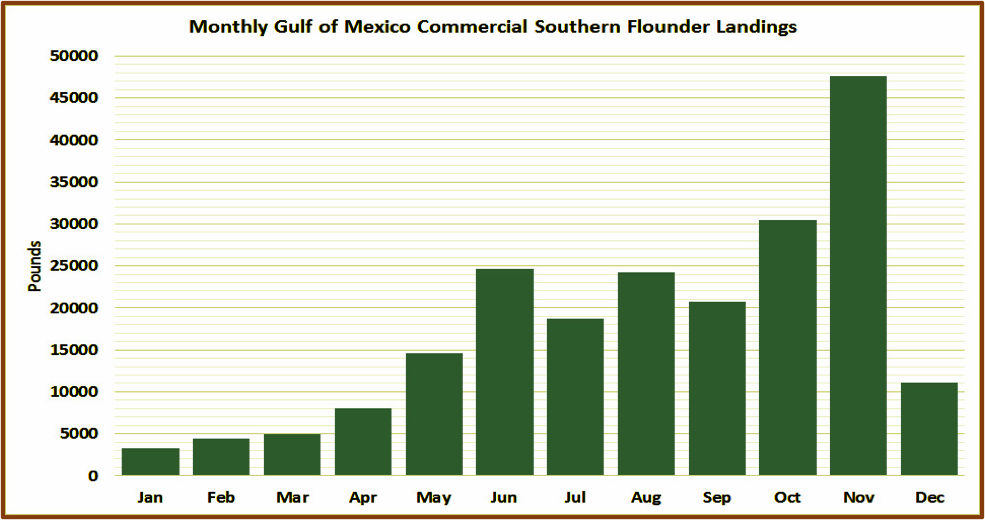Vol. 7 No. 14 | Commercial Southern Flounder Fishing in the Gulf of Mexico States
Authors
Your Extension Experts
Related News
June 2, 1995
March 31, 1995
Economic Contributions of Southern Flounder Commercial Fishing
Economic impact analysis shows the economic contribution an industry makes locally, region-wide, nation-wide, or globally. This economic information is crucial in making private investment decisions, formulating government policy, and developing research and extension programs for the industry. The IMPLAN (http://implan.com/) software and the 2013 input-output data for the five Gulf States were used to estimate the economic contribution of white shrimp commercial fishing to the Gulf of Mexico regional economy in 2015. The economic impact analysis used sector 17 or commercial fishing of the 2013 IMPLAN input-output data.

The IMPLAN economic model generates economic impact estimates regarding output or sales, employment or jobs, labor income, value added and tax revenues. The income, value-added, and output impacts are expressed in dollars for the year specified by the user. Output or sales are the gross sales by businesses within the economic region affected by an activity. Labor income includes personal income including wages and salaries and proprietors’ income or income from self-employment. Employment impacts are expressed in terms of a mix of both full-time and part-time jobs. Value-added is the contribution made to the value of seafood products at each stage of harvesting, processing, and distribution. The total economic impact is the sum of direct, indirect and induced impacts. The direct effects express the economic impacts in the sector in which the expenditure was initially made. Indirect effects result from changes in the economic activity of other industrial sectors which supply goods or services to the commercial fishing industry. Induced effects are the product of personal consumption expenditures by industry employees.
The annual commercial dockside values of Southern flounder in the Gulf of Mexico Region in 2015 reached $0.6 million, which is about twice the average annual dockside values during the last five years. The total economic contribution of commercial southern flounder fishing in 2015 amounted to $1.2 million (Figure 1). The Southern flounder commercial fishing created 17 jobs and generated labor income amounting to $0.4 million in the Gulf regional economy. The Southern flounder commercial fishing industry generates annual tax revenues for the Gulf States and the U.S. federal government. About $71,000 were estimated to have been paid by households and businesses in 2015 to the federal government as social insurance tax, tax on production and imports, corporate profit tax, and personal income tax. The Gulf States were expected to have collected taxes from households and businesses in 2015 amounting to $35,000 as social insurance tax, tax on production and imports, corporate profits tax, and personal tax.

According to Gulf FINFO (http://gulffishinfo.org/), Southern flounder (Figure 2) “are found in coastal waters of the western Atlantic Ocean, from North Carolina to the mouth of the Rio Grande River and southward into Mexico. In the Gulf, they’re usually found west of the Mississippi River. Southern flounder is mainly an inshore species but lives in a variety of habitats, depending on gender, life stage, and environmental factors. Larvae hatch offshore in the water column; currents transport them inshore to shallow estuaries and tidal rivers. Juveniles settle in shallow, grassy areas of estuaries where food is abundant. Adults spend the warmer months over muddy bottoms in upper estuaries and the fall and winter offshore (for spawning).”
Figure 3 shows the commercial landings of Southern flounder from the Gulf of Mexico Region since 2000. During the last five years, the Gulf States supplied 8.4% of the entire Southern flounder domestic landings averaging 138,000 pounds and valued at $314,000 annually. Louisiana is the largest producing state in the Gulf of Mexico, but nationwide, North Carolina supplied more than 94% of all domestically-caught Southern flounder.


In 2015, the Gulf-wide commercial landings of Southern flounder reached about 212,000 pounds. This fish species was caught year-round with most of the landings occurring from June to November (Figure 4). There are 136 fishing businesses, processing plants, seafood and fish markets, and seafood restaurants registered in MarketMaker which harvest, process, sell, and serve flounder in the United States. Click this LINK to view the search results online.
What is MarketMaker?
MarketMaker is the largest and most in-depth database of its kind featuring a diverse community of food-related businesses: buyers, farmers/ranchers, fisheries, farmers markets, processors/packers, wineries, restaurants, and more. MarketMaker provides simple yet powerful search tools to connect with others across the production and distribution chain (http://ms.foodmarketmaker.com/).
Where can you find Mississippi MarketMaker?
MarketMaker is located at http://ms.foodmarketmaker.com/.
Ask Siri or Cortana to search for “Mississippi MarketMaker” on your smart phone.
How do you register your food business in Mississippi MarketMaker?
Click Register and type your email address and a password in the spaces under Register. Be prepared to enter information (and pictures) about your business.
What are the benefits in registering your food business in Mississippi MarketMaker?
Producers register their businesses in MarketMaker because food buyers of all types access our database to find products and services to meet their specific needs. Through MarketMaker, producers can reach more buyers and more efficiently from profitable business alliances.
How do you search for your business profile in Mississippi MarketMaker?
Click Search and type the name of your business in the space under Search MarketMaker.
How do you update your business profile in Mississippi MarketMaker?
Click Register and then click UPDATE YOUR PROFILE. Type your email address and password in the spaces under Account Login. Be prepared to enter updated information (and pictures) about your business.
MarketMaker Training Workshops
This training workshop is available upon request by a group of 6-12 producers, extension agents, state regulatory agencies staff, and teachers. Each workshop will best fit the needs of the participants. Email Dr. Ben Posadas for details at ben.posadas@msstate.edu.
How do you search for local food businesses in Mississippi MarketMaker?
Click Search and type a keyword in the space under Search MarketMaker.
What is the Market Research tool of MarketMaker?
The MarketMaker research tool is an interactive mapping resource for identifying target markets, developing customized census profiles, and mapping food related businesses over demographic maps.
Where do you find the Market Research tool in MarketMaker?
Look for the Market Research section in MarketMaker and click Research your market now or Use previous version.